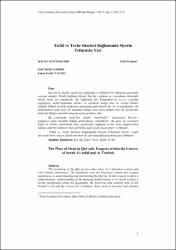Enfâl ve Tevbe Sûreleri Bağlamında Siyerin Tefsirdeki Yeri
Künye
Özaktan, Fatih (2015) Afyon Kocatepe Üniversitesi Sosyal Bilimler Dergisi / Enfâl ve Tevbe Sûreleri Bağlamında Siyerin Tefsirdeki Yeri / Cilt:17, Sayı:2, 2015, 1-27Özet
Kur’ân’ın nüzûlü, tarihi bir bağlamda ve kültürel bir etkileşim içerisinde
cereyan etmiştir. Tarihî bağlamı bilmek, Kur’ân’ı anlama ve yorumlama sürecinde
büyük önem arz etmektedir. Bu bağlamda Hz. Peygamber’in (s.a.s.) yaşadığı
coğrafyayı, tarihi-toplumsal şartları ve ayetlerin hangi olay ve soruya binâen
indiğini bilmek âyetteki maksadın anlaşılmasında önemli bir rol oynamaktadır. Bu
malumatlara ıttıla siyer ile mümkün olduğu için siyeri bilmek, Kur’ân âyetlerinin
maksudu İlâhiye mutabık anlaşılmasına yardımcı olur.
Bu çalışmada meâl’den ziyâde “meâl-tefsir” anlayışının Kur’ân’ı
anlamaya daha mutâbık olduğu gösterilmeye çalışılmıştır. Bu gaye ile incelenen
Enfâl ve Tevbe sûrelerinde bazı ayetlerdeki müphem yerler siyer bilgilerinden
istifade edilerek müfesser hale getirilmiş ilgili ayetin meal-tefsiri verilmiştir.
“Enfâl ve Tevbe Sûreleri Bağlamında Siyerin Tefsirdeki Yerini” tespit
sürecinde hem rivayet tefsirlerine hem de siyer kaynaklarına müracaat edilmiştir. The revelation of the Qur’an has taken place in a historical context and
with cultural interaction. The familiarity with the historical context has a great
significance in understanding and interpreting the Qur’an. In this respect, to have a
comprehensive understanding of the meaning behind verses, it is crucial to have a
strong background about the geography, the historical and cultural state of the
Prophet’s era and the reasons for revelation. Since sirah is an exact and detailed source of these information, mastering the knowledge of sirah is pivotal in
understanding the real objectives and divine intention behind the verses.
The aim of this study is to show that the ‘translation-exegesis’ combination
is more appropriate in understanding the Qur’an rather than relying on a mere
translation. For this purpose, the ambiguities in some verses from Surah al-Anfal
and Tawba are made clear through translation-exegeses combination technique by
reference to sirah sources.
In determining the place of sirah for exegesis of the two surahs, narration
based Qur’anic exegesis and sirah sources are used.



















